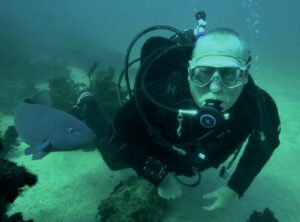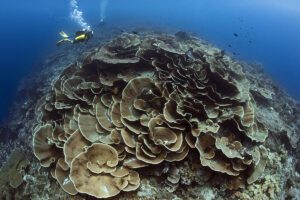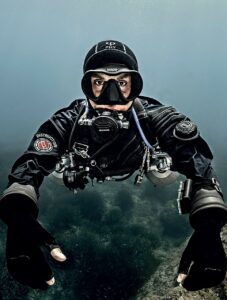Buying the best scuba drysuit is a big investment so, you want to be sure that you get the right one. And, I thought I’d draw up a complete drysuit buyers guide because I’ve been diving in a range of drysuits for most of my diving career and know what to look for on a drysuit.
Something that is always worth considering is after purchase care. Most divers can manage some basic repairs and there are places you can take your drysuit for more complex work however, the original manufacturer will always be the best to get your damaged drysuit back to it's former glory. Others can do the work but, it won't be as neat nor use official replacement parts so, it's best to consider suits that are manufactured in your home country.
So, lets kick things off with the age old question: neoprene or membrane?

Neoprene Vs Membrane
Which is better, neoprene or membrane drysuits? Each style drysuit suits a different type of diving and diver. If one were particularly better all-round, then we wouldn’t have the other anymore. Neoprene drysuits tend to be tougher and warmer. Even though they’re often compressed neoprene, they’re still a few millimeters thick which means that they can take a fair amount of abuse and also provide insulation so you don’t need a very thick undersuit.
The downsides of this are that they’re heavier and more buoyant so, you have to carry more lead around. Membrane drysuits on the other hand are just that: a very thin membrane of material with very little insulation. This makes them much lighter and very easy to repair.

Which is right for you, is very much up to you. For recreational diving membrane suits tend to be the most popular. For more commercial diving and dives in cold water where you’re not moving around a lot, divers tend to choose neoprene. But, you can use either for both.

Entry Zipper
Front zip and back zip are your two basic choices of drysuit zipper. Back zippers tend to run straight across the back of your shoulders. This means that they’re nice and straight and out of the way and you have plenty of room to get in and out. The only downside is that you need your buddy to zip you up and let you out if you’re desperate to get out.


Front entry are zippers that run from one shoulder to the opposite hip. You can get in and out of these all by yourself. They can be a little tricky if you’re not very flexible. But, you should have a telescopic body to give you extra space to get your head in.
Then we have two types of zipper itself: metal or plastic. Metal zippers are the same as the ones on space suits so, they're very tough and great at keeping water out. They can be a bit stiff to move if you don’t wax them and they don’t like to be bent. Plastic zippers are much easier to move and more flexible but, they still require lubrication from time to time. You tend to find brass zippers on backzips and plastic zippers on front zippers but, you can always find the opposite.



Neck & Wrist Seals
Three choices you have when it comes to drysuit seals and if you’re buying a brand new suit you often have the choice of all three. The most basic are latex. It’s a thin seal. The important thing to remember is that these stretch over time so, they’ll be really tight when they’re new. Resist the temptation to cut them until they’ve been stretched properly. Neoprene are ok, they're fairly tough compared to the others, you just have to be sure you get the right size because they're less forgiving if you have the wrong size.


Silicone are the new standard. A lot of new suits come with silicone seals and they’re very similar to latex in that they’re thin and stretchy. But, they do have the benefit that you always have a ring system to hold them in place which means that you can swap a broken seal in minutes and in most cases fit a dryglove system.

Boots or Socks
For your feet you can often get the choice of boots or socks. Integrated boots range from clunky rubber boots, sometimes with steel toe caps to soft tech boots with neoprene ankles and straps to keep your foot in place and everything in between. Integrated boots are good because they’re nice and simple and they’re attached to the suit, which makes donning and doffing much faster and easier.


Socks are typically neoprene or membrane socks that you then wear rock boots over the top. Benefit to these are that you have a full-on lace-up boot and if you ever wear through the rock boot, you just replace the rock boot and don’t have to send the whole drysuit away for repairs. The downside is that you can forget your boots, the extra cost of the rock boot and they take more time to get ready because you need to lace your boots up. Again they both have their pros and cons, which is best for you, might not be best for another diver.

Drysuit Valves
Another place you often get a choice with a new drysuit is the valves to inflate and deflate. You’re sometimes given the choice of Apeks or SiTech Valves. Apeks makes valves, SiTech make valves, they’re both quite similar in how they function, the main difference is the size of the hole that they cut into the drysuit because Apeks and SiTech Valves have different diameter fittings and you can’t mix and match.


Some drysuits you’ll get the choice of a cuff dump, which is just a smaller basic one-way valve on the wrist instead of your shoulder. Most divers prefer an auto shoulder dump, some divers like both. If you’re planning on using a heated undersuit you’ll need a new valve to get power from your external battery inside your drysuit so, you’ll need to know what size inflator you have fitted to your drysuit.

Thigh Pockets
One feature that you’ll love to see on your drysuit is a good pair of thigh pockets. You can live without thigh pockets but, gosh is it so much better when you have some great thigh pockets to store some stuff where you can easily reach it. Thigh pockets can range from open pouches that you can just slip things into. To full on zippered or Velcro closure, extendable pockets with separate sections inside to organize your stuff.



When it comes to drysuits, they tend to either come with pockets or without, it's rare that you get to choose different pockets, it’s just what the manufacturer puts on that particular suit. But, some nice features to see are anchor points on the inside like D-Rings or bungees that let you clip thing things to inside. Quick access pockets like a little zip at the top where you don’t need to open the entire pocket to reach something like a knife or spare double ender.

Breathability
Membrane drysuits can be made from a range of materials. A lot of divers call them trilaminate drysuits but we have quad-laminate and others so, I just call them membranes. Some are made to be tough and abrasion resistant, others light for travel. But, one nice feature to have if you spend a lot of time in your drysuit is a breathable material.
It makes very little difference underwater but, on the surface the drysuit is breathable like a fancy rain coat or hiking boots. It still keeps the water out but, it allows the sweat from inside out. A soon as you zip yourself into a drysuit it’s a sealed air-tight bag so your sweat has nowhere to go. Unless the material is breathable. If you tend to strip out of your suit right after the dive it won’t be that important but, if you do spend some surface time in your suit, it’s a nice feature to have.

Clever Features
Some drysuits have some aces up their sleeves that are either factory fitted or after-market additions. Some drysuits have built-in undersuits. It’s basically a mesh layer inside the suit that maintains a constant layer of air all around your suit. Some suits can have P-Valves fitted, which are just how they sound. A valve on your inner thigh that connects to a hose inside your suit that fits to an external catheter for those really long dives.

Mounting points on wrists to hold dive computers in place. Braces on the inside to hold the suit up if you take the top half off. Most drysuits have braces now. Drygloves, I’ve mentioned before. Some drysuit manufactures make their own, others have partnered with Kubi so they’re fitted from the factory or if you have latex cuffs you can fit Kubi to them yourself. Some drysuits have some special features so, it’s important you check them all out and see if you’re missing out on anything.

Undersuits
You need an undersuit to pair with a drysuit. And a decent undersuit is more than just an expensive set of sweats. Undersuits are constructed to wick moisture away from your body and in a lot of cases divers don’t know they’ve had a leak until after the dive and they realize their sleeve is wet. Undersuits are either traditional quilted material for volume or modern mesh that’s uncompressible.
Single piece and two piece options. Singles are handy in that it’s one suit so there’s no extra bulk on your mid section or risk of a bare patch if you stretch. The downside is that you may be limited in how much you can stretch if the material doesn’t allow. Two part, is just the opposite but they tend to be quite long around the waist to avoid bare patches. And just like ladies jeans, pockets are really handy for keys and things when you’re on the surface.

Made 2 Measure
Drysuits tend to come in off the shelf sizes as well as made to measure for an additional fee. Some divers automatically jump to made to measure because they think they’ll never find a size that fits them properly. But a lot of manufacturers now offer very wide size ranges that include tall, short, broad and relaxed sizes. They might not be in stock at your local dive centre but, they should be able to get them in if the manufacturer still makes the suit.
It's always worth trying on a couple off-the-shelf sizes in the undersuit that you’re planning to wear. It will be a hot and sweaty affair if the shop doesn’t have A/C but, you want to be sure that the suit is comfortable in what you’re going to wear and you may not need a M2M suit anyway. If it is M2M that you need to go for, double check every measurement, exactly where you measure from and to and what you should be wearing to make sure you give them the correct measurements because the suit you will receive is custom and it's your problem to fix if it doesn’t fit.









